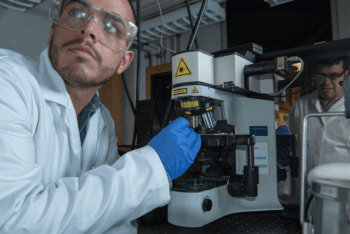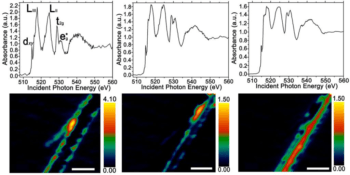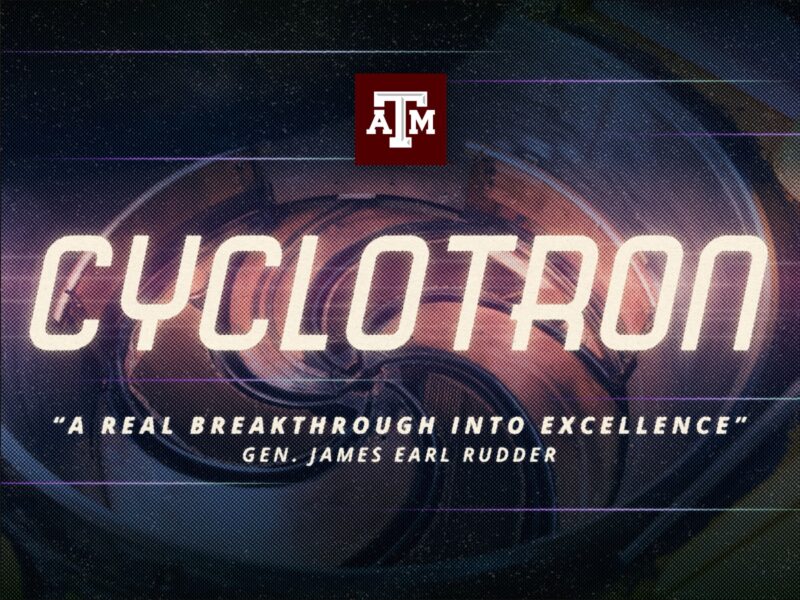Building A Better Battery

Forget mousetraps — today’s scientists will get the cheese if they manage to build a better battery.
An international team led by Texas A&M University chemist Sarbajit Banerjee is one step closer, thanks to new research published today (June 28) in the journal Nature Communications that has the potential to create more efficient batteries by shedding light on the cause of one of their biggest problems — a “traffic jam” of ions that slows down their charging and discharging process.
All batteries have three main components: two electrodes and an intervening electrolyte. Lithium ion batteries work under the so-called rocking-chair model. Imagine discharging and charging a battery as similar to the back-and-forth motion of a rocking chair. As the chair rocks one way, using its stored energy, lithium ions flow out of one electrode through the electrolyte and into the other electrode. Then as the chair rocks the other way, charging the battery after a day’s use, the reverse happens, emptying the second electrode of lithium ions.
“Fundamentally, when you have a battery, every time you use it, it starts to die a little bit,” Banerjee said. “The more you use it, the more it dies. Eventually, it becomes unusable. Theoretically speaking, you expect a certain performance from a battery, and you rarely ever get there. People have been at a loss to understand all the factors that contribute to this lack of full capacity. This study points us in that direction.”
Using one of the world’s most powerful soft X-ray microscopes — the Scanning Transmission X-ray Microscope (STXM) — at the Canadian Light Source (CLS) in tandem with decades of combined experience in materials science, Banerjee and collaborators from the Lawrence Berkeley National Laboratory, Binghamton University and the National Institute of Standards and Technology (NIST) were able to image a traffic jam of lithium ions chemically driven through the nanowire-based channels of a simulated battery.
“For a battery to function properly, you need to get lithium ions in, and you need to be able to pull them out,” Banerjee said. “Once our lithium ions got in, we were seeing that they sort of stop at some point along the way.”
Banerjee points to this interruption as a veritable ghost in the machine that not only slows everything down but also sometimes prevents the device — be it a cell phone or a laptop computer — from exploiting its full battery potential. He says the devil is in the details, which in this case clearly show that the electrons, once coupled with the lithium ions, appear content to sit instead of moving freely, thereby distorting the electronic structure and, in essence, trapping or stranding the flow of energy.
Two of Banerjee’s graduate students, Luis De Jesús and Gregory Horrocks, are joint first authors on the Nature paper detailing the team’s National Science Foundation-funded research, which also features a third Texas A&M graduate student, Abhishek Parija. Berkeley Lab staff scientist David Prendergast and postdoctoral fellow Yufeng Liang at Berkeley Lab’s Molecular Foundry, a U.S. Department of Energy National User Facility for Nanoscale Science Research, helped the Texas A&M team design and implement their calculations, which were experimentally verified by colleagues at Binghamton and using NIST National Synchrotron Light Source beamlines at Brookhaven National Laboratory supervised by Daniel Fischer. Calculations were conducted using Molecular Foundry as well as Texas A&M computing resources.

Berkeley Lab’s Prendergast notes that the team’s work demonstrates how X-rays can “see” small polarons — the combination of a charged particle (electron) and an associated structural distortion — through their impact on electronic structure around the oxygen atoms in the cathode. Small polarons previously have been proposed to be present in transport within Li-ion cathodes but have not been “seen” directly until now.
In order to make way for additional lithium to enter the structure, Prendergast says, the lithium ions need to diffuse, bringing their electrons in tow. But as a small polaron, it also has to carry along the structural distortion — a real drag for transport of charge in a material.
“Imagine wanting to move a house to a different site,” Prendergast said. “A wooden house can be transported in one piece, but a brick or stone house might have to be dismantled or demolished first.”
The team also was able to identify the specific site where the electron sits within the particle, down to the orbital. Interestingly enough, De Jesús says, the holdup always occurs at the same material-dependent point.
Once the lithium gets in, Banerjee notes there’s a very slight distortion that causes the electrons to get trapped in a plane, where they form what he describes as “puddles of charge” that are unable to link up and move as they should through the material.
“You can always draw an analogy between water and electrons,” Banerjee said. “They are making these little puddles, but until the puddles are connected, they can’t flow. Once you have enough electrons coming in, they can all link up and start flowing. But until that happens, they’re all stranded, and they can’t move to charge or discharge something. And so they go out and hang in different areas of the particle. They’re all sort of sitting, defining different regions, and they aren’t able to move easily.”
Continue reading on Texas A&M College of Science website.
This article by Shana K. Hutchins originally appeared on the Texas A&M College of Science website.





